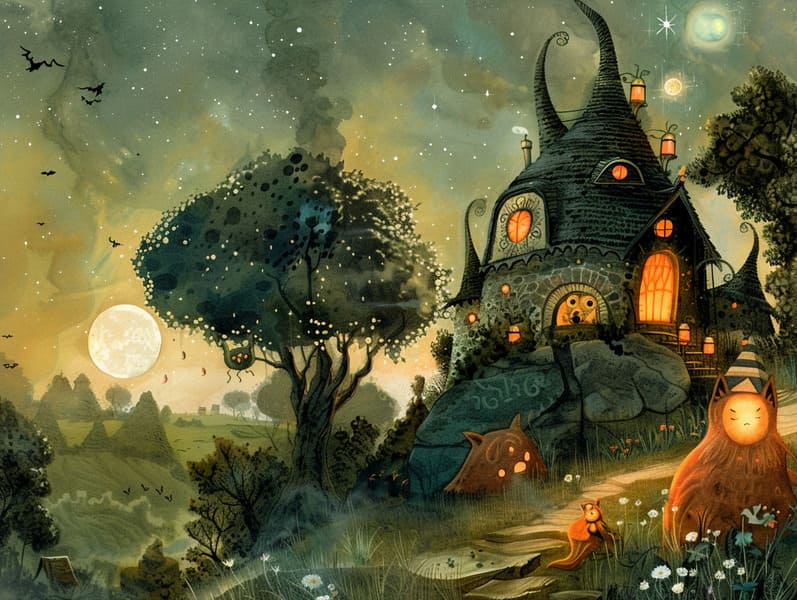
Old fairy tales have old origins. These tales have been whispered from one generation to the next far before they were ever transcribed. They were born from a variety of cultures, including Indigenous traditions. They were initially narrated among elders, often carrying themes and messages mirroring the societal norms and beliefs of the time.
Jacob and Wilhelm Grimm, Jacob and Wilhelm (the Grimm brothers), were among the first to gather many of these beloved narratives. Their collection, "Grimm's Children's Stories," included tales like "Ashenputtel," "Hansel and Gretel," and "Snow-White and Rose-Red," which have since become essentials in the world of beloved fairy tales. Similarly, Andersen's whimsical fairy tales, such as "The Mermaid," and "The Duckling's Story," have captured hearts worldwide, securing their place in the pantheon of beloved fairy tales.
Though they are centuries old, classic fairy tales remain as impactful as ever, especially as bedtime stories for kids. These magical stories are now available in multiple formats, including gorgeously illustrated books, magical animations, and web-based fairy tales.
Their enduring popularity can be credited to several charming aspects:
Life Lessons: Old fairy tales often impart important moral lessons. Narratives like "The Boy Who Cried Wolf" teach the merit of truth, while "The Tale of the Tortoise and the Hare" exemplify the values of perseverance and unpretentiousness. These stories offer kids clear distinctions between good and bad, forming their moral compass in a tender yet deep way.
Sympathy and Perception: Old fairy tales frequently involve protagonists facing obstacles and hardships, stimulating audiences to feel with their struggles and celebrate their triumphs. For instance, "Beauty's Beast" teaches us the merit of looking beyond appearances to know the real character of a person, developing insight and comprehension.
Cultural Perception: Many fairy tales are rich in the cultural contexts from which they were born. Exploring these narratives can provide delightful insights into different customs, building a sense of world respect and acknowledgment.
Fantasy and Imagination: The imaginative elements in fairy tales—spells and potions—invigorate children’s imaginations. These tales lead readers to imaginary realms, motivating fantastical thinking and a sense of curiosity that continues a lifetime.
Classic fairy tales are not only charming but also educational. They act as delightful tools in promoting various brain and heart skills in the young. When timeless fairy tales are narrated, they cultivate speaking abilities by presenting new lexicon and complicated sentence structures. This practice also advances auditory perception and focus, as young ones keep up with the story, expectant to see what happens next.
Furthermore, exploring the themes and characters of fairy tales can improve logical thinking and logical thinking. The young are instructed to detect patterns, expect results, and grasp cause and effect. These debates also encourage kids convey their thoughts and feelings, nurturing their emotional intelligence.
In today’s online age, the existence of web-based fairy tales has made these stories more available than ever. Web platforms and software give huge assortments of children's fairy tales that can be perused or listened via anytime, anywhere. Fairy tales read aloud are particularly well-received, featuring an captivating way for little ones to experience these fantastical tales. Read-aloud books and voiced videos move characters and settings to life, often accompanied by delightful background sounds and harmonies that boost the narrative adventure.
The timeless fascination of timeless fairy tales lies in their ability to adjust to new eras while sustaining their core messages. Contemporary revisions of these narratives often introduce more multicultural protagonists and modern settings, making them website accessible to today’s audience. However, the basic principles of heroism, understanding, and fair-mindedness remain unchanged, continuing to touch listeners of all ages.
Old fairy tales also offer a sense of protection and closeness. They introduce a well-arranged narrative with a evident beginning, middle, and end, often drawing to a close with the finalization of conflicts and the triumph of morality over immorality. This reliability can be heartening for kids, introducing a sense of sturdiness in an constantly changing world.
Timeless fairy tales continue to charm and enlighten new generations, maintaining their radiance and pertinence in modern society. As nighttime stories for kids, they grant access to a perfect blend of allure and teaching, nurturing moral values, empathy, and creativity. The prevalence of digital storybooks and the commonness of fairy tales read aloud ratify that these old tales remain obtainable to new generations.
By retaining and narrating these narratives, we continue to praise the rich tapestry of cultural legacy and cultural heritage. Whether you are seeing a artistically illustrated book, viewing a online collection, or listening via an audio story, the fascination of old fairy tales is always within reach. These narratives reveal of the endless influence of stories and its ability to connect us across eras and regions.
If you are viewing a richly illustrated book, seeing a electronic library, or hearing an audio story, the grandeur of ancient fairy tales is always within reach.
These narratives emphasize of the undying essence of fairy tales and its ability to connect us across generations and cultures, weaving a spell that delights and instructs alike.